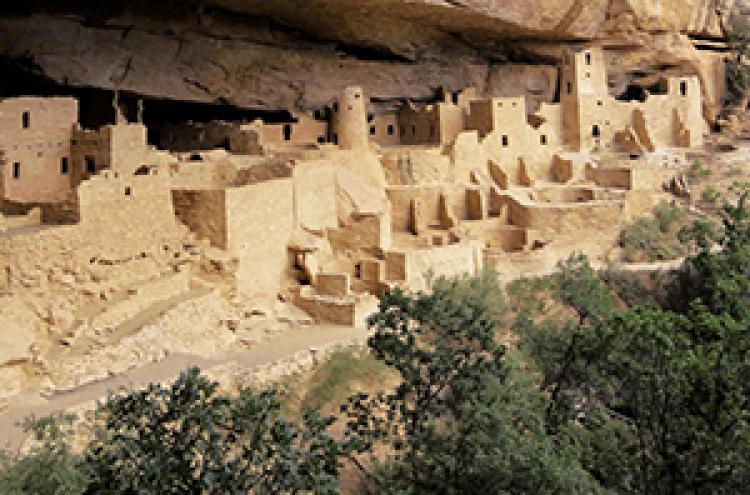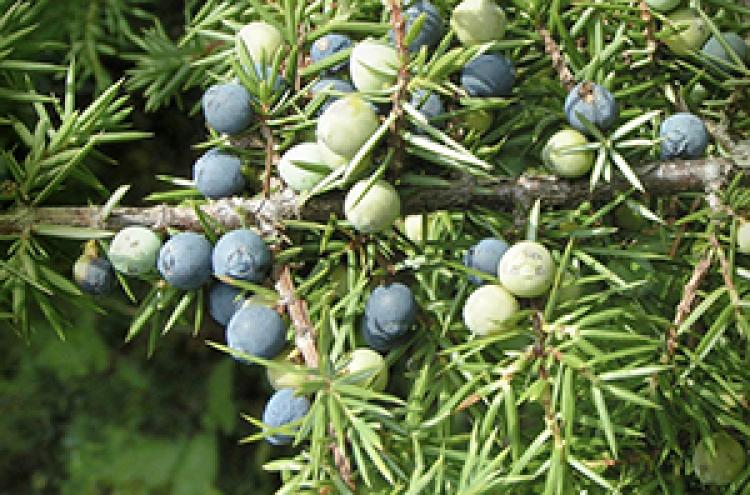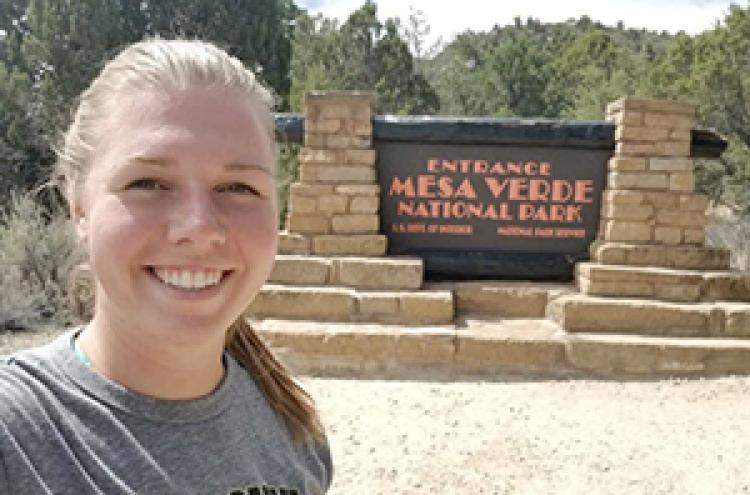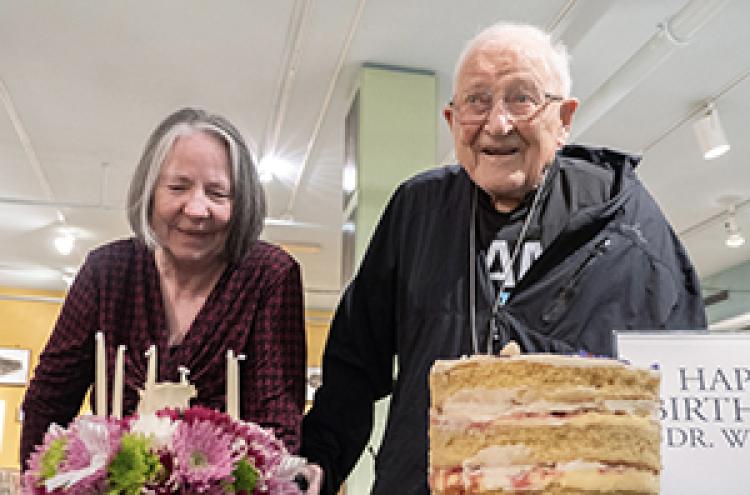Museum Matters: February 2019
 CU Museum of Natural History and Mesa Verde National Park Team Up
CU Museum of Natural History and Mesa Verde National Park Team Up

For the last two years, the CU Museum of Natural History (CUMNH) and Mesa Verde National Park (MEVE) have been collaborating on projects to increase scientific knowledge and enhance understanding of the natural world at this famous national park and UNESCO World Heritage Site, located in the southwest corner of Colorado. MEVE spans over 82 square miles and is located just an hour west of Durango and 15 minutes southeast of Cortez.
Initial discussions between the National Park Service (NPS) and the CUMNH centered on a curious, round building in the park called Far View Center. This building was designed originally as a theater in the round by the husband and wife architectural team of Joseph P. and Mary Louise Marlowe from Denver. It served as the visitor center for the park from 1968 until the opening of a new visitor center and collection facility in 2013.
The building was slated to be taken down. But the beautiful mid-century modern design, part of National Park Service “Mission 66” project nationwide, prompted several within and outside the Park Service to advocate for preservation. What was required was an appropriate “adaptive reuse” of the building. That is where the Museum of Natural History came into the picture.
Discussions between MEVE Superintendent Cliff Spencer and his staff and the CUMNH staff ensued to explore options for collaboration on the project. The revitalization of the Far View Center presents an opportunity to add exhibits and programs about the biodiversity of the region informed by scientific research, to the Park offerings. This will allow the science related to biodiversity research, including the responses of biodiversity to environmental change, to be more accessible to Park visitors.
In addition, collaboration with MEVE could enable the CUMNH to provide local schools with the Archaeology in the Classroom and Fossils in the Classroom kits that have enhanced science learning across the state.
A Historic Structures Report was completed and presented at a symposium at MEVE on June 30, 2018. That report suggests the building, with some renovation, could again support exhibitions, explainers, and other interpretive materials. The next step is to complete the necessary renovations and make the building ready for its next life.
 Biodiversity Research at MEVE
Biodiversity Research at MEVE

Members of the Museum faculty, along with faculty in the Anthropology Department, have worked in Mesa Verde National Park and the surrounding region for nearly 100 hundred years. Dr. William Weber, retired Curator of Botany, collected plants from the region and helped to establish a small herbarium as part of the Park’s collections. However, other scientific sections of the Museum have not been active in the region.
That changed this year when five different teams of faculty, collections managers, and students across the disciplines of Vertebrate Zoology, Entomology, Botany, Invertebrate Zoology, and Phycology applied for permits and worked with National Park Service scientists to facilitate expeditions to the Park. The five teams visited the Park over a six-month period, from April through September, 2018. Observational data and collections were taken from a wide range of habitats. This work was facilitated by NPS staff, who helped gain access to sites that would otherwise be off limits to the general public.
Some of the projects were related to on-going research, such as the response of mammals and their food items to changing climate. Others were new work, such as inventories of invertebrates and algae in springs associated with different cliff dwellings, which were thought to be critical water sources for residents in the cliff dwellings. Interestingly, the source of the water in these types of springs is not from below as in many spring systems, but from above.
The results of these studies won’t be published for a while, but initial evaluations of the collections suggest that, of the species that have been identified, some are new records for the state of Colorado and others are new to science entirely.
 Internship Opportunities at MEVE
Internship Opportunities at MEVE

While the research studies were on-going, two students in the Master of Science degree in Museum and Field Studies program did internships at the Park. Internships are an integral part of the museum’s interdisciplinary program. The hands-on experience gained at another organization that collects and stewards objects or interprets natural history for the public is crucial for student’s professional development.
For 8 weeks in summer 2018, Jane Richardson and Claire Steffen lived in Mesa Verde National Park. Richardson worked in the collections area of the Park, while Steffen worked with the interpretation staff, conducting a study of visitors.
The collections at MEVE number over 1 million objects, nearly all of them from within the Park’s boundaries. As a UNESCO World Heritage Site, the Park catalogues, stewards, and makes accessible the objects in their care for scholarship and education. Richardson graduates in May 2019, and aspires to be a collections manager working with anthropological artifacts. She gained invaluable experience with the extraordinary collections held at MEVE.
Steffen worked on a project to understand the visitation patterns in the Chapin Mesa Archaeological Museum, which is located within MEVE. Pursuing a career in an educational setting within a museum, her project involved interviewing visitors and staff, along with an observational study of the paths visitors took through the museum and the exhibitions at which they stayed the longest. Her study provides valuable data to the interpretation staff of MEVE, as they explore the possibility of renewing the exhibitions in that museum.
Both Richardson and Steffen were pleased with their enriching internship experiences at MEVE—a once-in-a-lifetime experience for each of them!
 Dr. William A. Weber Turns 100!
Dr. William A. Weber Turns 100!

Recently, CUMNH faculty, staff, and students, as well as members of the Weber family and friends, assembled in the BioLounge last month to wish Dr. Bill Weber a happy 100th birthday. The celebration took a familial tone, with everyone happy to share good stories and best wishes with Bill. Earlier in the month, Bill was honored at the CU Retired Faculty meeting, where his long list of scientific and cultural accomplishments was noted.
There are over 30 plant and lichen genera and species named by colleagues around the world in Bill’s honor. Which is fitting, because he famously built up the CU Museum Herbarium from a small number of specimens to over 600,000 specimens. Even today, some of these collections are considered by botanists to be the best in the world.
Bill was honored this past year by the International Lichenology Society and the American Bryological and Lichenological Societies for lifetime achievements in those disciplines.
Comings and Goings
- Dr. Leanne Elder (Invertebrate Zoology) and Jacob Van Veldhuizen (Paleontology) are new collections managers in the CUMNH, having just joined us in 2018.
- The Museum’s Advisory Board, a volunteer organization that provides advice, direction and support for the CUMNH, welcomed two new members this year, Marylou Harrison and Susan Petrakis.
- Long-time Board Member Jean Rodeck has rotated off the board. Jean is the daughter of former CUMNH Director Hugo Rodeck, who served from 1939 to 1971. Jean essentially “grew up at the museum” and then worked for many years in the National Park Service
We welcome your comments and feedback. Please email us with your thoughts.

